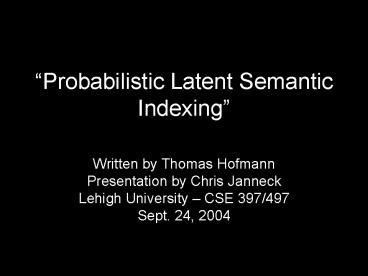Probabilistic Latent Semantic Indexing - PowerPoint PPT Presentation
1 / 17
Title:
Probabilistic Latent Semantic Indexing
Description:
'Probabilistic Latent Semantic Indexing' Written by Thomas Hofmann ... Perplexity: Inverse of its. likelihood. Conclusions. PLSI is a good thing because ... – PowerPoint PPT presentation
Number of Views:473
Avg rating:3.0/5.0
Title: Probabilistic Latent Semantic Indexing
1
Probabilistic Latent Semantic Indexing
- Written by Thomas Hofmann
- Presentation by Chris Janneck
- Lehigh University CSE 397/497
- Sept. 24, 2004
2
Overview
- Introduction
- LSI review
- PLSI introduction
- Aspect Model
- Tempered Expectation Maximization
- Geometrical Description
- LSI-PLSI comparison
- Similarities
- Differences
- Experiments
- Conclusion
3
Intro If it werent for the people
- Problem effective information retrieval
- Corpus of data
- Constantly increasing
- Primarily text
- (Human) user requests answers to be retrieved
from corpus - Uses natural language query user-formulated
query, often similar to spoken/written language - Human languages introduce ambivalence polysemy,
synonomy - Simple term matching is no longer sufficient
4
Latent Semantic Indexing (LSI)
- Popular retrieval enhancement procedure
- Reduces dimensionality for faster and (ideally)
more relevant results - Decompose term-doc matrix
- Using Singular Value Decomposition (SVD)
- Break into
- Term-K matrix (U)
- K-K (rank-rank) matrix (S)
- Doc-K matrix (V)
- Sort and eliminate rows with smaller ks
- Dimension reduction via truncation
5
Probabilistic LSI
- Uses LSI idea, but based in probability theory
- Comes from statistical Aspect Model
- Generate co-occurrence model based on
non-observed class - This is a mixture model
- Models a distribution through a mixture (weighted
sum) of other distributions - Independence Assumptions
- Observed pairs (doc, word) are generated randomly
- Conditional independence conditioned on latent
class, words are generated independently of
document
6
Aspect Model
- Generation process
- Choose a doc d with prob P(d)
- There are N ds
- Choose a latent class z with (generated) prob
P(zd) - There are K zs, and K ltlt N
- Generate a word w with (generated) prob P(wz)
- This creates pair (d, w), without direct concern
for z - Joining the probabilities gives you
Remember P(zd) means probability of z, given d
7
Aspect Model (2)
- Log-likelihood
- Maximize this to find P(d), P(zd), P(wz)
- Bayes format end up with
- This is conceptually different than LSI
- Doc-specific word distributions, P(wd), are
based on combination of specific
classes/factors/aspects, P(wz) - Not just assigned to nearest cluster
8
Tempered Expectation Maximization
- EM is common technique to maximize likelihood
estimation - Alternates between
- E-step calculate future probabilities of z based
on current estimates - M-step update estimate parameters based on
calculated probabilities
9
Tempered Expectation Maximization (2)
- Tempered include control b, where blt1
- Use this b until performance plateaus, then
change by b hb, where hlt1 - Stop when no better performance after change
10
Geometrical Description
- Prob distributions can now be mapped in K-1
dimensional space - Instead of M-1
- Since K-1 lt M-1, this is dimension reduction
- M-1 is dimensions of all possible multinomials
- Even though discrete points are mapped, convex
hull provides continuous space
11
Similarities LSI and PLSI
- Using intermediate, latent, non-observed data for
classification (hence the L) - Can compose Joint Probability similar to LSI SVD
- U ? U_hat P(di zk)
- V ? V_hat P(wj zk)
- S ? S_hat diag(P(zk))k
- JP U_hatS_hatV_hat
- JP is simliar to SVD term-doc matrix N
- Values calculated probabilistically
12
Differences LSI and PLSI
- Basis
- LSI term frequencies (usually) and performs
dimension reduction via projection or 0-ing
weaker components - PLSI statistical generate (mostly random)
model of probabilistic relation between W, D and
Z refine until effective model is produced
13
Experiments
14
Experiments (2)
R3
R1
R2
R4
15
Experiments (3)
16
Experiments (4)
Perplexity Inverse of its likelihood
17
Conclusions
- PLSI is a good thing because
- Consistently better Prec/Rec curves than LSI
- TEM SVD, computationally
- Better from a modeling sense
- Uses likelihood of sampling and aims for
maximization - SVD uses L2-norm or other implicit Gaussian
noise assumption - Polysemy is recognizable
- By viewing P(wz)
- Similar handling of synonomy































